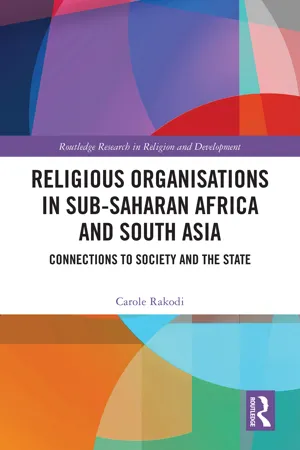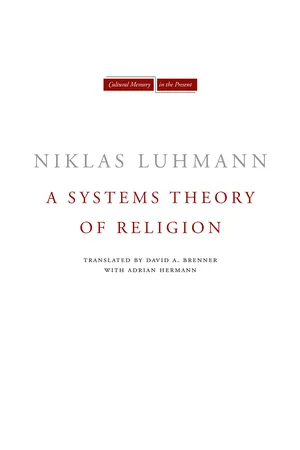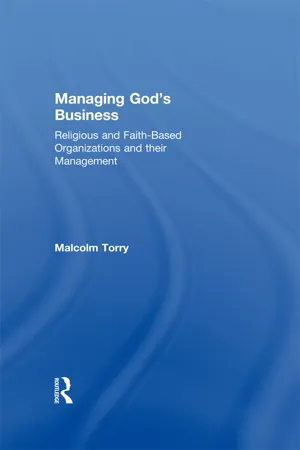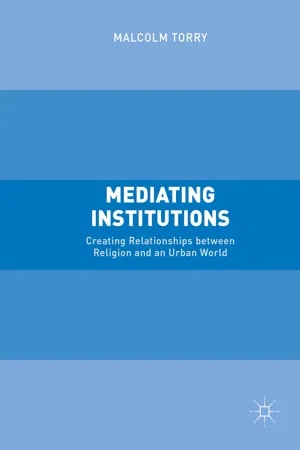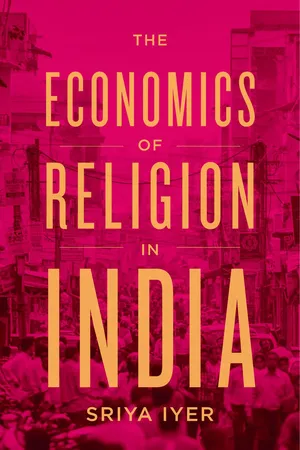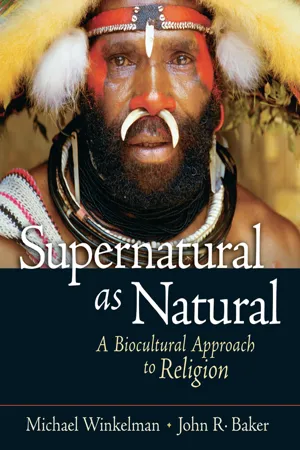Social Sciences
Religious Organisation
A religious organization is a group or institution that is dedicated to the practice, study, and promotion of a particular religion or belief system. These organizations often have a hierarchical structure, with leaders, clergy, and members who participate in religious rituals, services, and community activities. They may also be involved in charitable work, education, and outreach to spread their religious teachings.
Written by Perlego with AI-assistance
Related key terms
6 Key excerpts on "Religious Organisation"
- eBook - ePub
Religious Organisations in Sub-Saharan Africa and South Asia
Connections to Society and the State
- Carole Rakodi(Author)
- 2024(Publication Date)
- Routledge(Publisher)
The aim is not to produce a single overarching theory. Rather, each of the elements of the framework, it is suggested, can be seen as an axis along which differentiation occurs, producing a matrix within which empirical analyses can be located to identify the elements that are key to understanding the interactions between religions and societies. This incorporates religion not only as a source of institutions (rules and norms) that underpin social relationships, but also as a social field that has personal, social and organisational dimensions organised at different levels, including the household; ‘congregation’ or ‘community’; regional and national levels of social, economic and political systems (including national or intermediate Religious Organisational levels such as churches, sects and denominations); and transnational dimensions. It is in this multilevel context that religious and other sociopolitical organisations interact with each other. To understand these interactions, four domains of religion need to be explored: discourses and beliefs, practices, the characteristics of religious groups and their organisational arrangements (Beckford, 1984, 2015 ; Hinings and Raynard, 2014 ; Lincoln, 2006, 2014). Religious Organisations are conceived as including NGO-like organisations, religious hierarchies and bureaucracies, congregations and other religious actors. Both their internal organisation and their relations with states, governments and wider social groups are important in understanding their characteristics and social roles, the processes by which they become institutionalised and bureaucratised, their structures of authority and decision-making, including patterns and practices of leadership, the sources and scale of resources they can mobilise and the regulatory mechanisms to which they are subject or which they impose on adherents - eBook - ePub
- Niklas Luhmann, André Kieserling, David Brenner, Adrian Hermann(Authors)
- 2013(Publication Date)
- Stanford University Press(Publisher)
6 Religious Organizations I In all function systems of modern society, organized social systems play an important, indispensable role. It would be surprising if this were different in the case of religion. Yet it is difficult to imagine that organized decision processes operate in the form of religious actions, that decisions constraining an organization are made in the form of a common prayer or are merely accompanied by a request for divine inspiration. Archives are not sacred objects even in church administrations, and majority decisions have to be made and implemented even when individual participants believe those decisions deviate from God’s declared will. 1 The Old European tradition, the implications of which reach far into modernity, did not distinguish clearly between society and organization. The organizational conception of the present did not even emerge as something separate from the general semantics of order and organism until the nineteenth century. 2 Society itself was understood (in very different conceptual variants) as a natural order of human living together, the result of a social contract motivated by nature. That tradition can be summed up in a term such as “corporation.” In the process, it also becomes clear that this terminology distinguishes what it signifies from families or family households. People are born naturally into these, and they define everyone’s place in the differentiated order of society. Organization mediates between the production of religious meaning, resulting in myths or dogmas, and the daily practice of specifically religious behavior. It thereby takes the place (even when organizing sects) that sects had occupied in the ancient world—whether ancestors in families were being worshipped or rituals were being institutionalized socially - eBook - ePub
Managing God's Business
Religious and Faith-Based Organizations and their Management
- Malcolm Torry(Author)
- 2017(Publication Date)
- Routledge(Publisher)
It might be better to do what we do in fact do, and pick a prototype. Christian congregations, synagogues, Sikh and Hindu temples, and mosques, are religious organizations (and Jeavons is right to suggest that they are the only unambiguously religious organizations; Jeavons 1998). So the British Humanist Association might be a religious organization, and Tate and Lyle is not one. By comparing other organizations with those organizations which are undeniably ‘religious organizations’ (with the two words always taken together, as religious organizations might not always be religious on the basis of some definitions of that word) we can decide whether they are at the centre of the category, whether they are to some extent religious organizations, whether they belong on the boundary of the category, or whether they are not religious organizations at all. By doing this we shall be doing what Peter Clarke and Peter Byrne invite us to do and operate a ‘family resemblance’ strategy for defining religion and religious organizations (Clarke and Byrne 1993).I suggested that the first problem we face when defining ‘religious organization’ is the definition of ‘religion’. An alternative strategy is suggested by the mention of institutions and practices in Durkheim’s and Griffin’s definitions of religion, by Alata’s definition of religion as a ‘way of life’ (Alata 1977) and by Bruce’s decision to ignore inner spiritual states because they are so difficult to study and instead to define religion in terms of individual and group behaviour (Bruce 1995: vii). In the same way, we could define religion in terms of institutions and their members’ activity, thus obviating the need to define ‘religion’ at all because religion then becomes religious organizations and their memberships.Defining Faith-Based Organizations
We experience the same problems with faith-based organizations as we experienced employing the classical method of definition with religious organizations. By ‘faith’ we might mean either a particular ‘Faith’ or a faithful attitude of some kind; and we shall then need to ask to what extent an organization is influenced by that Faith or that faith. For an organization to be ‘based’ on a faith could mean either that a particular Faith or kind of faithfulness provides some of its values, or we might mean that it is closely governed by that Faith’s religious organizations. - eBook - ePub
Mediating Institutions
Creating Relationships between Religion and an Urban World
- Malcolm Torry(Author)
- 2016(Publication Date)
- Palgrave Macmillan(Publisher)
is possible to put together the necessary relationships during a crisis, but it will always be easier to create the required active relationships if good relationships already exist between religious and other organisations and between religious and other institutions.In a society in which a variety of secularisations and desecularisations are occurring at the same time, it might be tempting to avoid the difficult task of bridging the gaps between organisations in different sectors and between religious and other institutions. A shifting and complex context can create anxiety, and can lead Religious Organisations and individuals to concentrate on their own agendas, and other civil society organisations and institutions to get on with the many other tasks demanding their attention. This would be a mistake. In a shifting and complex context it is even more important to create good relationships between the different sectors. It will never be energy wasted.Internal and External Aspects of Organisations
The position that we have reached is this: Society is made up of individuals, but it is also constituted by institutions, among which are organisations. Similarly, religion is a matter of individual commitment, but it is also institutional and organisational. Our times are characterised by a variety of secularisations, among which is institutional secularisation: the distancing of religious and secular organisations from each other, and the distancing of religious and secular institutions from each other. So educational organisations and other institutions have become less religious, and at the same time educational and specifically Religious Organisations have become more distant from each other. This means that in the educational world, relationships between educational institutions and religious institutions have largely disintegrated, and faith-based educational organisations have shifted in a secular direction. - eBook - ePub
- Sriya Iyer(Author)
- 2018(Publication Date)
- Belknap Press(Publisher)
Chapter 2 , India is characterized by a multiplicity of religions, the active practice of religion, and religious conflict, which has been commented upon extensively by historians, political scientists, and sociologists (Bayly 1983; Engineer 1995; Bagchi 1991; Varshney 2002; Brass 2003). Some estimates have suggested that there are over thirty thousand Muslim and other religious schools in India (United States Department of State 2010). Yet large-scale economic surveys of the activities of religious organizations in India are conspicuously absent. Our study tries to fill this gap.Of all the religious services provided by the organizations, propagation of the faith and religious education are considered the two most important activities. Compared to Hindu organizations, Muslim and Christian organizations provide more religious education, which they rate as their main activity. Religious organizations in India differentiate themselves on the strength of their religious beliefs with respect to other organizations. These findings are discussed in more detail in Chapter 4 . The findings pertaining to nonreligious services are discussed in more detail in Chapter 5 .One theme in the economics of religion literature is that many religious groups have provided social services such as education, as shown, for example, in a national study of congregations in the United States (Chaves 2004). There are also examples from the developing world, such as Hamas and Hezbollah, which have provided spiritual services alongside social and welfare services in the regions where they operate (Berman 2009). As E. Berman points out, this approach emphasizes the social and economic aspects of religious communities, rather than simply the effect of religious faith.2The question is, why do religious organizations provide social services? Altering the interpretation of religious doctrine and practice is one channel through which religious differentiation might take place, but changing the service levels provided by religious organizations, particularly with respect to education and health, may be another channel—especially where these services are less well provided by the state. The balance between the secular provision of public services and the provision of religious services is important. Consequently, it may be important to examine the relationship between religion and service provision because some theologically strict religions argue that providing social services is only a means to attain spiritual ends, or to promote religious conversion. More liberal religions argue that providing social services is a moral imperative and thus an end in itself, regardless of whether those who are served convert to the religion. I argue that for other religions, the provision of social services may arise in response to economic inequality, or even as a means of survival in multireligious communities in which religions that do not provide these services may face declining numbers of adherents. - eBook - ePub
Supernatural as Natural
A Biocultural Approach to Religion
- Michael Winkelman, John R. Baker(Authors)
- 2015(Publication Date)
- Routledge(Publisher)
Geertz’s understanding of religion emphasizes its capacity to provide a framework for integrating and giving meaning to many aspects of human experience. The role of religious systems in socialization includes its ability to shape personal development. A key aspect of religion’s ability to produce this structuring of indigenous psychology is its use of ritual to produce powerful emotional experiences and to associate particular meanings with these moods and motivations. Ritual makes these interpretations particularly “real” by associating them with powerful transcendent experiences.Religion and Social Control
All societies must teach their members about acceptable and unacceptable behavior and exert some degree of control over the deviants who undermine the social order. Tensions are inevitable within any society, and people need ways to settle disputes, determine guilt or innocence, and punish transgressors. In small-scale societies, when problems arose, people looked to the group’s elders, who provided answers on the basis of their own judgment in the matter, or to religious functionaries, who provided answers after consultation with the spirits.The simplest principle that humans use to organize their societies is kinship. Unilineal kinship systems make it clear to whom a person is related and whom they can marry. Such kinship groups also regulate inheritance and provide a structure for dealing with conflict. Problems that arise between members of the same lineage are handled within the lineage, usually by the elders. Problems that occur between members of different lineages involve each lineage in its corporate or group form. If a member of one lineage kills a member of another, the offending lineage may be required to rectify the damage caused by providing a payment. If this payment is considered insufficient, if the harm is too grievous, or if the two lineages do not enjoy an otherwise peaceful relationship, a feud
Index pages curate the most relevant extracts from our library of academic textbooks. They’ve been created using an in-house natural language model (NLM), each adding context and meaning to key research topics.
